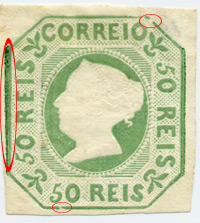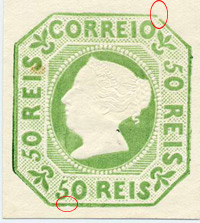 |  |  |
50Reis
D.Maria (original- 1853) | 1863
Reprint (for comparaison only) | 1885
Reprint |
DISTINGUISHING CHARACTERISTICS OF THE REPRINT:
-the genuine stamps have no breaks in the frame or else have a single break in the lower frame. The frame of the 1885 reprint has the same break below that some originals also have, and a second break on the right side, very near the top angle, as the 1863 reprint has. On the left side the frame is only slightly over-inked, but has constant width, unlike the 1863 reprint. The paper is very white and much thicker than either the original or the 1863 reprint. The ink is bright and the print looks considerably lighter than the original. The reprint was issued ungummed.
IMPORTANT NOTICE: It is said that there are original stamps with the two frame breaks but I have never seen one. If one turns out, the left frame overinking (a secondary mark in itself) should be used as decisive to identify a 1863 reprint, while the paper thickness and color should be enough to identify a 1885 reprint.
Watch out for "posted 50R stamps" made from 1885 reprints with the top frame break covered by the postmark or by a small drop of green watercolor (these will show as a darker spot when viewed against the light).
CARACTERÍSTICAS DISTINTIVAS DA REIMPRESSÃO:
-os selos originais tinham a moldura completa ou então tinham apenas uma falha em baixo (ver o selo central na ilustração acima). A moldura da reimpressão de 1885 tem a falta inferior e uma outra no canto superior direito, junto ao vértice (tal como a reimpressão de 1863). O lado esquerdo da moldura tem algum empastamento de tinta mas a moldura tem largura constante, ao contrário da da reimpressão de 1863 que alarga para cima. O papel da reimpressão é muito branco e consideravelmente mais espesso do que, quer o original, quer a reimpressão de 1863. A cor é viva e mais clara do que a do original. A reimpressão foi emitida sem goma.
NOTAS IMPORTANTES: Li que haveria alguns originais com as duas faltas, mas nunca vi nenhum exemplo. Em caso de dúvida o empastamento (uma marca que em si não oferece total confiança) pode ser usada como tira-teimas em relação à reimpressão de 1863, enquanto que o papel muito branco e espesso distingue a reimpressão de 1885.
Cuidado com "selos originais" fabricados a partir de reimpressões com carimbos falsos que cobrem a falha superior. Cuidado, também, com exemplares com a falha pintada a aguarela (que se detecta observando o selo contra a luz).
Bibliografia:
Vieira, A. "Selos clássicos de relevo de Portugal", Porto, 1983:
Lamas, J. "Estudo das reimpressões de selos portugueses", Lisboa, 1948.